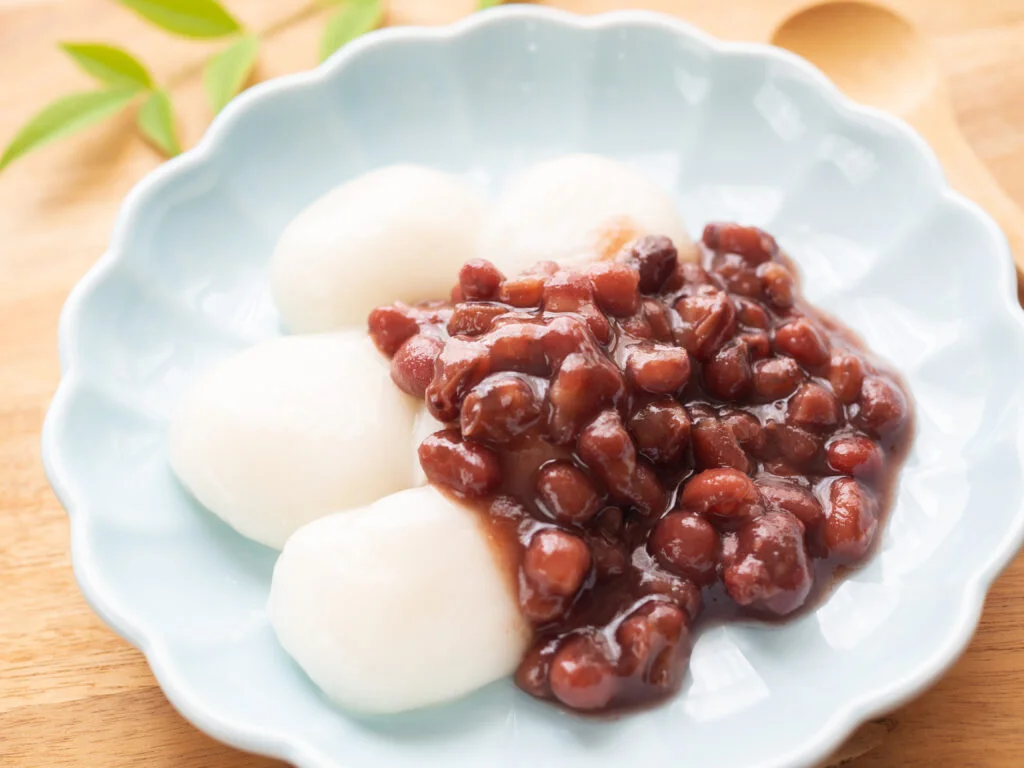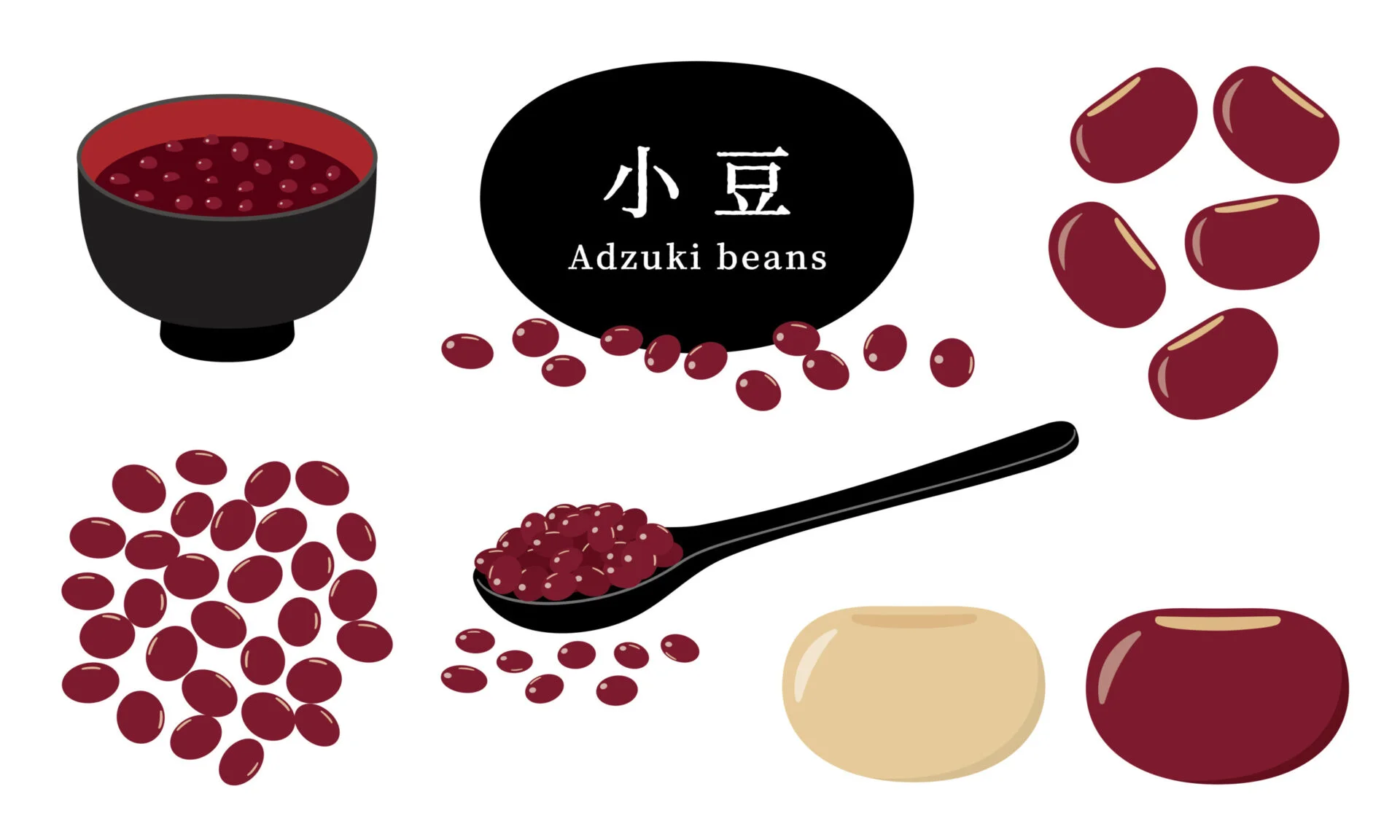Azuki Beans: The Foundation of Wagashi and Japanese Sweets Culture
Azuki beans are an indispensable part of Japanese food culture. Their vibrant red color and distinctive flavor add both visual appeal and taste to many traditional sweets and dishes. However, the allure of azuki goes beyond mere taste. These small beans are deeply embedded in Japanese history, culture, and spirituality. Let’s explore the long relationship between azuki and the Japanese people, unraveling its cultural significance.

Ancient Origins: Azuki Beans in Prehistoric Japanese Cuisine
The relationship between azuki and the Japanese people dates back to the Jomon period. Archaeological excavations have uncovered azuki seeds from mid-Jomon period sites (approximately 5,000 years ago). This provides valuable evidence that the Japanese were consuming azuki from very ancient times.
For the people of that era, azuki was a precious source of protein and a highly nutritious food. Its long shelf life also made it a valuable food source during winter months. It’s believed that during this period, azuki was primarily eaten boiled.
Azuki in Rituals: From Sacred Symbol to Celebratory Sweets
With the spread of rice cultivation in the Yayoi period, the cultivation of azuki also became more widespread. From this time, azuki began to play an important role not just as a food, but also in rituals and ceremonies.
The red color of azuki came to be believed to have the power to ward off evil spirits and prevent misfortune. For example, the tradition of eating “sekihan” (red rice) during special occasions is based on this belief.
The Birth of Wagashi: Azuki’s Role in Japanese Tea Ceremony Sweets
With the introduction of Zen Buddhism in the Kamakura period, the tea ceremony began to develop. The spread of tea ceremony culture greatly influenced the development of wagashi (traditional Japanese sweets). From this time, azuki became a primary ingredient in wagashi.
In particular, “an” (sweet bean paste) made by boiling and mashing azuki beans and adding sugar, became the foundation for many wagashi. The smooth texture and refined sweetness of an created a perfect balance with the bitterness of tea, becoming an essential element in tea ceremony aesthetics.
Edo Period: The Golden Age of Azuki in Japanese Desserts
With the spread of sugar during the Edo period, sweets made with azuki became more common. Many wagashi that are still popular today were born during this period. For example, dorayaki, daifuku, and yokan are representative azuki sweets that originated in the Edo period.
Sweet dishes made with azuki, such as “zenzai” and “oshiruko,” also became popular among common people. These dishes were believed to have a warming effect on cold winter days and became staple winter menu items.
Traditional Events and Customs Involving Azuki
Azuki has played an important role in traditional Japanese events and customs. Its red color and auspicious associations have led to its use in various settings.
For instance, there is a custom of eating azuki porridge on January 15th, known as “Koshogatsu” (Little New Year). According to documents from the Ministry of Agriculture, Forestry and Fisheries, this custom is believed to ward off evil spirits and pray for good health.
Azuki is also used in some regions for “mamemaki,” the custom of throwing beans to drive away evil spirits during Setsubun. This is particularly common in Hokkaido and the Tohoku region, where the red color of azuki is believed to have the power to ward off evil spirits.
These traditional events and customs, while varying slightly by region and household, demonstrate how deeply ingrained azuki is in Japanese life.
From the Meiji Era Onward: Scientific Evaluation and New Possibilities
Since the Meiji era, scientific research on the nutritional value and effects of azuki has progressed. Studies are being conducted on the nutritional components and functionality of azuki. For example, components such as dietary fiber and polyphenols found in azuki are attracting attention, although further research is needed to determine their specific health benefits.
Today, azuki is used not only as an ingredient in wagashi but also in bread, ice cream, and even as a raw material for cosmetics, expanding its applications. With growing interest in Japanese food culture overseas, dishes and sweets using azuki are also gaining attention internationally.
Conclusion: Azuki Weaving Japanese Culture and Tradition
Azuki beans have been an integral part of Japanese sweets and desserts for centuries. From their humble beginnings in prehistoric Japan to their starring role in modern wagashi, these small red beans have shaped the landscape of Japanese confectionery. As you savor your next piece of wagashi or Japanese dessert, remember the rich history and cultural significance embodied in each sweet bite of azuki. These beans are not just an ingredient; they are a testament to Japan’s enduring love affair with the art of confectionery.
